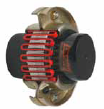Zhejiang Wenxian Gear Co., Ltd. | [email protected]
Grid Coupling Assortment Method
The following information and facts is important when making a Grid coupling selection:
Description of motor or engine, the horse electrical power (or KW), and RPM at slowest coupling velocity even though beneath load
Description of the driven gear
Shaft and keyway sizes along with the type of fit for driver and driven equipment (clearance or interference)**
Shaft separation (BSE)
Bodily room limitations (see Application Worksheet)
Determine what the environmental disorders are going to be, this kind of as temperature, corrosive conditions, interference from surrounding structures, etc.
By default, sizes 1020 – 1090 will likely be clearance fit, sizes 1100 – 1200 will likely be interference fit.
** Machines all bores and keyways to meet the dimensional and tolerance specifications per ANSI/AGMA 9002-B04 for inch bores, or ISO 286-2 for metric bores.
Standard grid couplings include two grid hubs, a grid spring, in addition to a cover assembly. When the shaft separation needs a spacer design coupling, the coupling will consist of two shaft hubs, two spacer hubs, a grid spring, and also a horizontal cover assembly.
Formulas Utilized To Determine Torque:
Application Torque (in-lbs) = ( horse power x 63025 ) /RPM
Application Torque (Nm) = ( horse power x 9550 ) /RPM
Variety Torque = Application Torque x Support Issue
High Peak Loads and Brake Applications
For applications where high peak loads or high braking torques may be existing, the next supplemental data will be important:
System peak torque and frequency
Duty cycle
Brake torque rating
The selection torque formula is similar to the formula shown above except that the application torque must be doubled  before applying the service factor.
before applying the service factor.
Application Torque (in-lbs) = ( horse energy x 63025 ) /RPM
Application Torque (Nm) = ( horse power x 9550 ) /RPM
Selection Torque = 2 x Application Torque x Services Aspect
Actions In Picking out A Grid Coupling
Phase 1: Establish the application torque applying the formula shown over.
Step two: Decide on the Services Aspect from the charts .
For applications not displayed use the chart shown towards the suitable. Figure out the Variety Torque working with the formula proven over.
Phase 3: Working with the variety torque as calculated, refer to your Performance Chart
Phase four: Review the maximum bore to the dimension picked and guarantee the needed bore sizes usually do not exceed the maximum allowable. In the event the essential bore size is larger, step as much as the next size coupling and verify to find out in the event the bore sizes will fit.
Phase 5: Applying the chosen coupling size, evaluate the bore and keyway sizes
Phase 6: Get in touch with your regional industrial supplier together with the component numbers to spot sizes using the charts for UPC part numbers.
